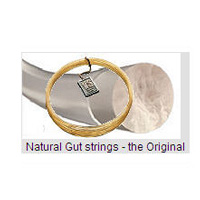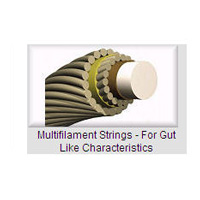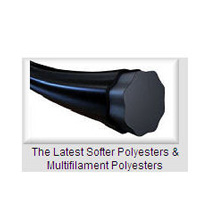Best Tennis Strings of 2022: A Complete Guide
Best Tennis Strings of 2022: A Complete Guide
Since you’re here, you must be in need of some advice on the best tennis strings, am I right? Just like choosing a tennis racquet, picking the right tennis strings for you is an important decision as well. Not only can the right strings help you to improve as well as advance to the next level, it should also fit with your playstyle and needs so that you can play as comfortably as you can out on the courts. There are tons of tennis strings and different brands out there however so you might have a hard time deciding. But with this guide, you’ll be a tennis string expert in no time. Here are tips on choosing the best tennis strings for you!
How to Choose the Best Tennis Strings
Factors to Consider
It’s important before you go buying tennis strings to consider what will work best for you. Your play style, your preferences regarding feel and elasticity, and your optimal tension are just a few factors that you should consider, among other things. Read through each section below to get a better feel of what strings will serve you best.
Price
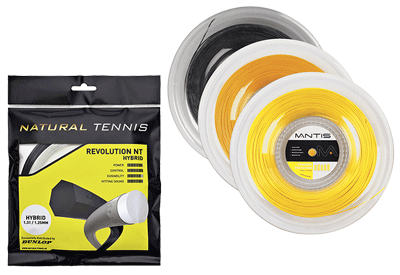 The price of tennis strings will normally vary anywhere from $5 to $15 while natural gut will average around $25 to $55 for an individual set of strings. The price usually depends on the material and the gauge which decides the feel or durability. The higher the cost of the strings, the better the performance is while reducing the chances of tennis elbow.
The price of tennis strings will normally vary anywhere from $5 to $15 while natural gut will average around $25 to $55 for an individual set of strings. The price usually depends on the material and the gauge which decides the feel or durability. The higher the cost of the strings, the better the performance is while reducing the chances of tennis elbow.
Also, when buying strings, there are 3 different types you can buy: individual sets (40ft), 330ft reels, and 660ft reels. The individual sets can only string one tennis racquet with the amount of string you get while 330ft reels can string up to 8 racquets (40ft x 8=320ft). Last but not least, the 660ft reel allows you to string up to 16 racquets (40ft x 16=640ft)! If you’re going to be needing new strings often and prefer a specific type of string, then buying reels will be cheaper in the long term. The only strings that don’t come in reels are natural gut and some multi-filaments.
Durability
How long do you want your strings to last? The longer strings lasts, the more you’ll be able to play. You’ll also be able to save more money this way by investing in a long-lasting pair of strings. However, important to note is that the more you play, the more tension will drop over time resulting in a different feel which might mess up your game. Therefore, playing with a durable set of strings means you should re-check the tension of your strings every so often.
Elasticity
Elasticity refers to how flexible your strings are, the more flexible, the more power it will be able to produce. The higher the elasticity, the more a string will be able to deform and spring back to its original position, also providing for a softer feel. Elasticity is an important factor to consider when choosing the best tennis strings, especially if you value feel or power.
Tension
Different strings have different tensions that you can adjust it to. The lower the tension, the more power you’ll have although the strings will snap faster. On the opposite end, the higher the tension, the more control you’ll have but it will strain your elbows more, leading to a higher chance of tennis elbow. For racquet stringing instructions and tension recommendations, visit this page.
| Tension Type | Tension in lbs. | More: | Less: |
| Low | <50 lbs. |
|
|
| In-Between | 50-60 lbs. | —————— | —————— |
| High | >60 lbs. |
|
|
Playability/Feel
This is one of the biggest factors to think about. Some strings will be able to give you more topspin while others will give you more power. Also, some strings will put less strain on your elbow with a softer feel. The best tennis strings for you should fit with what you want you strings to feel like, so choose accordingly.
String Gauge
String gauge refers to the thickness of the string. How it works is that the thinner the string, the more playability improves; for example, you get more spin out of the ball. The thicker the string, the more durable it is. In tennis, the string gauge ranges from 15 being the thickest to 19 being the thinnest. Then there is something called half gauges, which is represented by the number and a L (15L or 17L). These half gauge are between the numbers; for example, 15L is thinner than 15 but thicker than 16. Confusing right? Sorry, but I didn’t make this lame string system. Here is a chart to make it a bit easier for you to visualize:
| String Gauge | Thickness | ||
| 15 | 1.41-1.49mm | 17 | 1.20-1.24mm |
| 15L | 1.34-1.40mm | 17L | 1.16-1.20mm |
| 16 | 1.26-1.33mm | 18 | 1.10-1.16mm |
| 16L | 1.22-12.6mm | 19 | 1.00-1.10mm |
Shock/Strain
Different types of tennis strings will deliver different levels of strain to the arm. A stiffer and more durable set of strings–for example Kevlar or polyester–are not recommended for players who have tennis elbow or require more comfort. Something like natural gut or multi-filaments would be best for a harsher shock, making them easy on the arms.
String Construction
| Monofilaments: As you can guess, monofilaments are strings made of a single solid filament. Often made of polyester or kevlar, this type of string construction is one of the most durable although also one of the stiffest. For the most part, monofilaments are usually found in hybrid sets of strings, and recommended for chronic string breakers. | Multifilament: Also known as “multis”, these are strings that have more than one filament. These strings are known for having many filaments of nylon but can have other material too such as Kevlar. This type of string offers more elasticity than single filament but lacks the durability of other strings. Unlike natural gut, these strings can’t be strung with high tension. |
- Solid core/outer wrap: There are string options that have a solid core and either one outer wrap or multiple outer wraps. Popular nylon string construction, retains tension well with a crisp feel
- Textured: An extra filament is added for a raised ridge on the surface, allowing for a little extra grip on the ball for better spin
- Composites: Combination of different materials meshed together
Comparing the Different Types of Tennis Strings
| Type of String | Shock | Feel/Playability | Durability | Price |
|
Natural gut
|
Low | Very high | Low | $$$ |
|
Multi-filament
|
Low | High | Low-medium | $$ |
|
Polyester
|
High | Low | Very high | $$ |
|
Synthetic gut/nylon
|
Medium | Medium-High | Medium | $ |
|
Hybrids
|
Varies | Varies | Medium | $$ |
|
Kevlar
|
High | Low | Very high | $$ |
Best Tennis Strings Comparison Chart
***Most string recommendations will be in 16g by default, although other gauges might also be available***
Natural Gut
The only string made out of natural product from animal intestines, more specifically, a cow’s intestines. You probably could have guessed that since they are called natural gut. When twisted into tennis strings, they give a feel like no other and will protect your elbow from getting hurt. You can also string them with high tension for more control. Natural gut is the oldest type of string that remains in tennis today and is regarded by many as the best tennis strings. However, they are also the most expensive strings available, and will cost you a pretty penny every time you need to have your racquet re-strung. That’s probably why they aren’t recommended for players who snap their strings regularly.
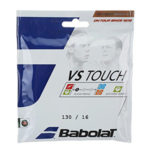 | 15 / 16 / 17 | Set | $$$$ | 4.8 |
Luxilon Natural Gut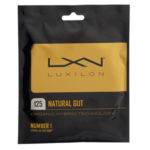 | 16 / 17 | Set | $$$$ | 4.7 |
Wilson Natural Gut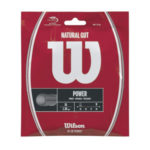 | 16 / 17 | Set | $$$$ | 4.5 |
Multi-Filament
Made of multiple filaments wrapped around a single string, multi-filaments are the closest you’ll get to natural gut tennis strings at a fraction of the cost. They have very good performance, are soft on the arms, but aren’t as durable or control oriented as other strings on the market.
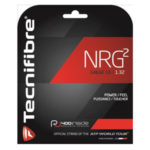 | 16 / 17 / 18 | Set | $$ | 4.4 |
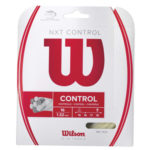 | 16 / 17 | Set | $$ | 3.9 |
 | 16 / 17 / 18 | Set | $$ | 4.2 |
Synthetic Gut/Nylon
Refers to any type of string that isn’t natural gut. Often made of nylon in a single filament although other materials can also be added for durability and feel. Synthetic gut is the cheapest type of string to manufacture and is generally the least expensive to purchase, making it the best tennis strings for budget players. This type of string aims to imitate the feel of real natural gut without costing as much, although recently multi-filaments do a better job of this. But don’t be fooled, even though these strings are cheap they have great durability and playability.
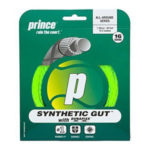 | 15 / 16 / 17 | Set/Reel | $ | 4.2 |
 | 16 / 17 | Set | $ | 4.4 |
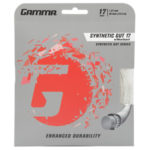 | 15 / 16 / 17 / 18 | Set/Reel | $ | 4.3 |
Polyester
Very stiff with durable material. These strings are frequently used for people who snap their strings a lot. The string supports people with heavy topspin which made it the most popular type of string in the pro tour.
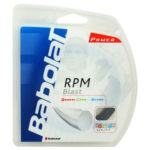 | 15 / 16 / 17 / 18 | Set/Reel | $$ | 4.7 |
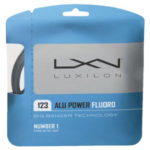 | 17 | Set/Reel | $$ | 4.5 |
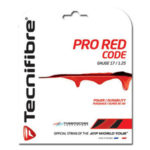 | 16 / 17 / 18 | Set | $$ | 4.4 |
Hybrids
Not really a string but more of a combination of 2 different strings on one racquet. You have 2 different types of string: 1 of them is the strings going vertically, which is called the main. The other is the strings going horizontally, which is called the cross. The main is usually the most durable string like Polyester or Kevlar. The reason for this is because you pop the main strings faster if you hit topspin. The cross is the opposite, it’s mostly based on comfort. You can still pop the cross with topspin but it will take much longer than having them on the main. When stringing, 20ft of each string will be required.
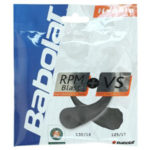 | Co-poly + Natural Gut | 17 RPM Blast + 16 VS | Set | $$$ | 4.6 |
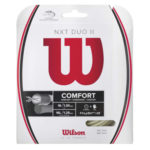 | Multifilament + Co-Poly | 16 (NXT + Luxilon Adrenaline) | Set | $$ | 4.5 |
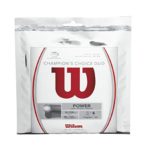 | Natural Gut + Co-Poly | 16 (Natural Gut + Luxilon ALU Power Rough) | Set | $$$$ | 4.7 |
Kevlar
Stiffest string and extremely hard to break. These strings are one of the best tennis strings that can hold its tension but it is also the most dangerous string as it can lead to the development of tennis elbow due to its stiffness. Kevlar is often strung with another type of string as it helps to combine the qualities of both strings (Hybrid), such as Kevlar with nylon to balance out the harsh feel. Another strategy to increase comfort and improve rebound efficiency is to string Kevlar at low tension.
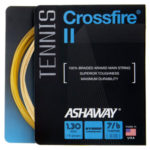 | 16 Synthetic gut/Kevlar | Set | $ | 4.4 |
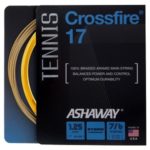 | 17 Synthetic gut/Kevlar | Set | $ | 4.2 |

